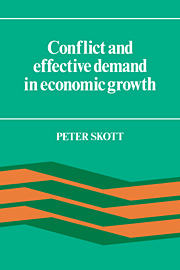Book contents
- Frontmatter
- Contents
- Guide to text notation
- Acknowledgements
- 1 Introduction
- 2 Methodological issues
- 3 A survey of some post-Keynesian and neo-Marxian ideas
- 4 The model
- 5 Ultra-short-run, short-run and steady-growth equilibria
- 6 Investment, instability and cycles
- 7 Finance and money-wage neutrality
- 8 Distributional questions in neo-Marxian and post-Keynesian theory
- 9 Final remarks
- Bibliography
- Index
3 - A survey of some post-Keynesian and neo-Marxian ideas
Published online by Cambridge University Press: 05 January 2012
- Frontmatter
- Contents
- Guide to text notation
- Acknowledgements
- 1 Introduction
- 2 Methodological issues
- 3 A survey of some post-Keynesian and neo-Marxian ideas
- 4 The model
- 5 Ultra-short-run, short-run and steady-growth equilibria
- 6 Investment, instability and cycles
- 7 Finance and money-wage neutrality
- 8 Distributional questions in neo-Marxian and post-Keynesian theory
- 9 Final remarks
- Bibliography
- Index
Summary
INTRODUCTION
The majority of economists and policy-makers in our time appear to believe that markets can solve most economic problems efficaciously. The theories of Keynes and Marx are either considered old-fashioned and simplistic, or (in the former case) they are adapted and modified beyond recognition. In my view the traditions of Keynes and Marx have much to tell us about contemporary economic events but in this review the emphasis will be on shortcomings rather than achievements. The criticisms, however, call into question neither the importance of the writings in general nor their central influence on my own approach.
HARROD
The publication in 1939 of Harrod's ‘An essay in dynamic theory’ marked the birth of modern growth theory. Keynes had published the General Theory three years earlier and Harrod was deeply influenced by the new ideas. He felt, however, that the General Theory was too static and that a more dynamic approach was needed.
In the General Theory, Keynes focused on the relation between current investment and current demand (and output). The stock of capital goods as well as the time path of output up to the present period were seen as historically given, but the analysis did not include these predetermined variables explicitly: the rates of increase of the capital stock and of the different categories of demand were not considered. Modifications of the analysis in this direction may seem like modest steps.
- Type
- Chapter
- Information
- Conflict and Effective Demand in Economic Growth , pp. 18 - 41Publisher: Cambridge University PressPrint publication year: 1989



